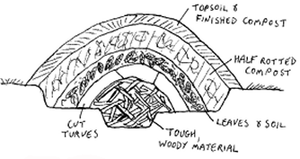
The German (or 'Magic') mound composting method is a good way of dealing with excess amounts of woody garden wastes, e.g., prunings, hedge clippings, brassica stems, brashwood, etc.
In summary, the technique involves digging a circular trench about 1' deep and 5' wide, in the centre of which is dug another 1' deep hole into which the rough material is piled. Turves are then stacked face down onto this pile, then layers of compost, well rotted leaves, manure, etc. are added. The layers gradually break down slowly releasing nutrients and creating rich humus over four or five years; this is ideal for growing hungry crops such as courgettes or strawberries.
Principles of the German Mound
Hugelkultur, the technique behind the German mound, is based on the natural process of decomposition. Key principles include:
- Layering Organic Materials: The mound is built by layering logs, branches, leaves, grass clippings, and compost. This creates a rich, nutrient-dense environment for plants.
- Water Retention: The decaying wood acts like a sponge, retaining moisture and reducing the need for frequent watering.
- Soil Enrichment: As the organic materials decompose, they release nutrients that enrich the soil, promoting healthy plant growth.
Benefits of the German Mound
- Improved Soil Fertility: The decomposing materials in the mound continuously release nutrients, enhancing soil fertility over time.
- Water Conservation: The wood within the mound retains water, making it an excellent solution for dry climates or areas with limited water resources.
- Sustainable Waste Management: Hugelkultur provides an effective way to recycle yard waste, reducing the need for disposal and landfill use.
- Biodiversity: The mound creates a diverse habitat for beneficial insects and microorganisms, supporting a healthy garden ecosystem.
- Extended Growing Season: The decomposition process generates heat, which can help extend the growing season by warming the soil.
Steps to Create a German Mound
- Select a Location: Choose a well-drained site with good sunlight exposure.
- Prepare the Base: Dig a trench about 1 to 2 feet deep to form the base of the mound. This trench will help stabilize the structure and provide space for the initial layers.
- Add Wood and Large Branches: Place logs, branches, and other woody materials at the bottom of the trench. These will form the core of the mound.
- Layer Organic Materials: Add layers of leaves, grass clippings, and compost on top of the wood. Each layer should be watered thoroughly to promote decomposition.
- Top with Soil: Cover the entire mound with a layer of topsoil, ensuring it is well-distributed and level.
- Planting: Once the mound is built, you can start planting. Choose a variety of plants to maximize biodiversity and create a resilient garden.
Maintenance and Tips
- Watering: Initially, the mound will require regular watering until the wood starts to retain moisture. Over time, the need for watering will decrease.
- Mulching: Adding mulch to the surface can help retain moisture and suppress weeds.
- Monitoring: Keep an eye on the mound for any signs of erosion or nutrient deficiencies and address them promptly.
Conclusion
The German mound, or Hugelkultur bed, is a powerful and sustainable gardening technique that benefits both the gardener and the environment. By understanding its principles and benefits, gardeners can create productive and eco-friendly gardens that thrive with minimal inputs.